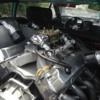This winter I swithed from a dualplane manifold with a 770 avanger to a single plane victor jr with a Holly 750 Ultra on my 427w. The heads (RHS 215 cc runners) and manifold were both quite extensively ported at the same time.
The engine character has changed – losing some torque under 3000 rpm, but boy has it picked up power above (cam is a Comp cams 294H). Compared to before I really like it – it has a more racy character that suits the pantera a lot better, I think. With that carb. there is a lot more adjustment to play around with and using my vacuum gauge I think I’ve dialed it in pretty good such that it idles reasonably smoothly (for that cam) around 8-900 rpm, and pull clean from around 1600-1700 rpm in high gear. It never ran better than it does now.
However, I have one issue with hot starts that I didn’t have with the dualplane and the 770 avenger. When the motor is warm it needs maybe 3-5 seconds on the starter and half throttle before it starts. Starter turns fine. I’ve leaned it out as much as possible, played around with secondary idle throttleblade opening to prevent too much exposure of transfer slots and even put in a phenolic spacer for heat insulation but I still can’t seem to solve the problem. Looking down the carb after I have shut it down the throttle blades are slightly wet of fuel and it smells a little from fumes standing next to the car.
Any suggestions to what the "problem" could be?
Kristian
Original Post



